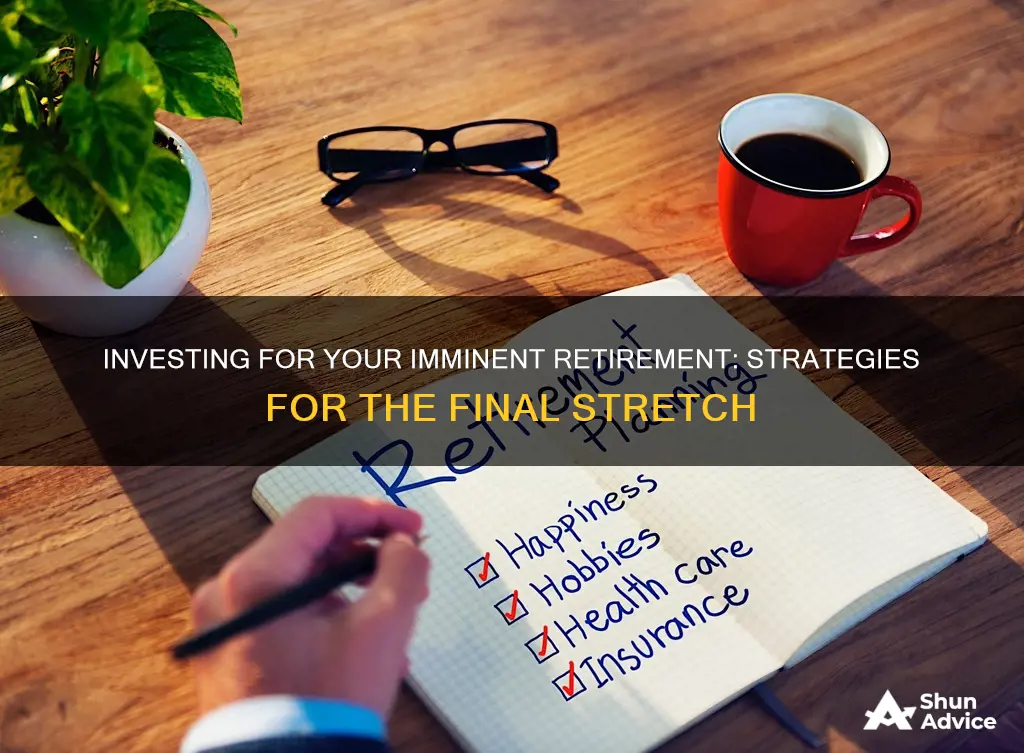
If you're retiring in seven years, it's important to start thinking about your investment strategy. Here are some key considerations to help you make the most of your retirement savings:
- Calculate your retirement expenses and income to determine how much you'll need to cover with your savings.
- Decide on an appropriate asset mix for your investments, including stocks, bonds, and cash investments, that aligns with your risk tolerance and timeline.
- Consider working with a financial advisor to develop a personalised investment plan that takes into account your specific circumstances and goals.
- Evaluate your current financial situation and make any necessary adjustments to reach your retirement goals. This may include cutting back on expenses, increasing your income, or both.
- Explore different investment options such as annuities, bond portfolios, total return approaches, and income-producing equities.
- Remember that investing for retirement is a long-term strategy, and it's important to stay disciplined and creative in your approach.
| Characteristics | Values |
|---|---|
| Time until retirement | 7 years |
| Average retirement age | 61-67 |
| Retirement income sources | Social Security, pension, savings, investments |
| Retirement income replacement | 55% to 80% of pre-retirement work pay |
| Investment options | Annuities, bonds, stocks, real estate, money market funds, CDs, high-yield savings accounts |
| Investment approach | Diversification, tax efficiency, total return, income-producing equities |
| Emergency fund | 3-6 months' worth of living expenses |
| Retirement expenses | Healthcare, housing, groceries, travel, insurance |
What You'll Learn

Calculate your retirement expenses and income
When planning for retirement, it's important to calculate your retirement expenses and income to ensure you have enough saved. Here are some steps to help you with this process:
Determine your retirement expenses:
- Identify your expected retirement age and life expectancy: Consider the age at which you plan to retire and how long you expect to live. This will help you calculate the number of years your retirement savings need to last.
- Estimate your monthly expenses during retirement: Consider your desired lifestyle and the costs associated with it. Include essential expenses such as housing, utilities, groceries, transportation, and healthcare. Don't forget to factor in occasional expenses, such as travel, hobbies, and gifts.
- Factor in inflation: Remember that the cost of living will likely increase over time due to inflation. Use an inflation calculator to estimate future costs based on expected inflation rates.
- Calculate your total retirement expenses: Multiply your expected monthly expenses by 12 to get an annual estimate. Then, multiply this amount by the number of years you expect to be in retirement. This will give you an idea of the total expenses you need to cover.
Estimate your retirement income:
- Social Security benefits: Research the Social Security benefits you are entitled to receive during retirement. This will typically replace about 40% of your pre-retirement earnings, but it may vary depending on your income level.
- Pension and other retirement plans: If you have a pension or other retirement plans, such as a 401(k) or IRA, calculate the expected income from these sources. Consider the returns on your investments and how they might grow over time.
- Part-time work: If you plan to continue working part-time during retirement, estimate the income you expect to earn from this source.
- Other sources of income: Include any other sources of income you anticipate during retirement, such as rental properties, business ventures, or royalties.
Compare your retirement expenses and income:
- Subtract your total estimated retirement income from your total expected retirement expenses. This will give you an idea of whether you have a surplus or a shortfall.
- Adjust your savings and investments: If you have a shortfall, consider increasing your contributions to savings and investments. If you have a surplus, you may want to reallocate some of those funds to other financial goals or enjoy them during your retirement.
Remember, it's crucial to start planning for retirement as early as possible. The earlier you begin saving and investing, the more time your money has to grow. Consider working with a financial advisor or using online retirement calculators to help you make informed decisions and ensure your retirement plan is on track.
The RRSP Dilemma: Investing for the Future or Paying Off Debt?
You may want to see also

Determine if you can safely withdraw this amount
When determining how much you can safely withdraw from your retirement savings each year, you can use the Safe Withdrawal Rate (SWR) method. This is a conservative approach that aims to balance your living expenses with the goal of not depleting your retirement savings prematurely.
The SWR method is based on the value of your portfolio at the time of your retirement. Most financial advisors recommend withdrawing between 3% to 4% of your total retirement fund balance annually, adjusted for inflation. This means you should be spending the returns on your investments rather than the principal amount.
To calculate your safe withdrawal rate, use the following formula:
Safe withdrawal rate = annual withdrawal amount ÷ total amount saved
For example, if you have $800,000 saved and believe you need $35,000 per year in retirement, your safe withdrawal rate would be 4.3% ($35,000 ÷ $800,000 = 0.043 or 4.3%).
If you only needed $25,000 per year, you could safely withdraw this amount as it would be 3% of your balance. However, if you wanted to withdraw $45,000 per year, you would need to save more money, as a withdrawal rate of 5.6% may lead to you running out of money.
It's important to note that the SWR method has limitations. It doesn't account for changes in your portfolio performance over time and is dependent on economic conditions at the time of your retirement. Additionally, being overly conservative with your withdrawal rate could result in a lower standard of living than necessary.
An alternative to the SWR method is dynamic updating, which involves regularly reevaluating your withdrawal amount based on inflation and the value of your portfolio.
Investments: Best Bets for Today
You may want to see also

Decide which accounts to withdraw from first
When it comes to deciding which accounts to withdraw from first during retirement, there are several strategies and factors to consider. Here are some detailed guidelines to help you make informed decisions:
Cash and Emergency Funds:
Start by using your cash or cash equivalents as your first source of income during retirement. This approach ensures that your fast-growing, riskier investments have more time to grow. Additionally, withdrawing from cash will help keep your taxes low during the early years of retirement. It is recommended to maintain an emergency fund that can cover at least six months' worth of expenses.
Taxable Accounts:
Once you've withdrawn from your cash reserves, the next step is to tap into your taxable investments. These include individual, joint, and revocable trust accounts. Withdrawals from these accounts are typically taxed at more favourable long-term capital gains rates if held for over a year. As these accounts are not tax-deferred, they will generally grow more slowly than retirement accounts.
Social Security:
The timing of when to start receiving Social Security benefits is a personal decision that depends on various factors. Social Security retirement benefits are available as early as age 62, but waiting until a later age, such as 70, can result in higher monthly payments. Consider your life expectancy, tax implications, and legacy considerations when deciding on the optimal time to start receiving these benefits.
Pre-tax Retirement Accounts:
Traditional IRAs, 401(k)s, 403(b)s, SEP IRAs, and similar accounts are typically tax-deferred, and withdrawals are taxed as income. Therefore, it is often advantageous to delay withdrawals from these accounts for as long as possible. However, keep in mind the required minimum distribution (RMD) rules, as you will be required to start taking withdrawals by a certain age (currently 73, increasing to 75 in 2033).
Roth Accounts:
Roth IRAs and similar accounts offer tax-free growth, and qualified withdrawals are also tax-free. These accounts are highly tax-efficient, and it is generally advisable to leave them untouched for as long as possible to maximize their benefits. Additionally, Roth IRAs can be excellent tools for legacy planning, as disbursements can be deferred for 10 years after the account owner's death.
Remember, the above guidelines provide a standard withdrawal order, but there may be exceptions depending on your specific circumstances. It is always recommended to consult with a qualified financial advisor or planner to tailor a strategy that aligns with your retirement goals, risk tolerance, and tax situation.
Planning for the Longevity of Your Retirement Investments
You may want to see also

Consider a bridge account
If you're retiring in seven years, you may want to consider a bridge account to help you navigate the financial limbo between retiring and claiming your Social Security benefits. A bridge account can be your financial lifeline, especially if you're retiring before the age of 62 or waiting until you're 70 to claim your benefits so you can get the maximum amount.
- Withdrawing from retirement accounts: You can tap into your retirement accounts such as Roth IRAs and 401(k)s. Keep in mind that each account has different rules around withdrawals, which may come with penalties if you are retiring before the age of 59.5. Withdrawing a small percentage of your accrued interest can help you avoid touching the principal balance. However, changing market conditions and the risk of taking out too much cash may make this strategy less optimal.
- Using an annuity laddering strategy: This strategy allows you to utilise annuity contracts to generate income and manage interest rate risks while you wait for your Social Security payouts. For example, you can get a short-term annuity that pays out over five years while allocating money to a deferred, fixed index annuity. The income benefits on the deferred annuity grow, and you can use the income from the short-term annuity as a bridge. Annuities offer guaranteed income streams, but interest rates are increasing, which could eat into your payout.
- Using a bond or CD ladder: By stacking financial products such as bonds or certificates of deposit (CDs), you can build a bridge of income. Bond laddering is a popular option, as you can purchase a series of bonds that mature at different time periods. CD ladders work similarly, but they may require more money upfront due to low-interest earnings.
- Brokerage account: A brokerage account can give you more ownership over your investments. You can manage the account yourself or with a financial advisor. Brokerage accounts involve buying and selling securities such as stocks and bonds through a stockbroker, who is paid on commission. There are no early withdrawal penalties, and if your income is low enough, you may benefit from zero capital gains and lower dividend taxes.
When considering a bridge account, it's important to evaluate your financial situation, lifestyle, and future goals. Ask yourself questions such as your desired retirement age, expected Social Security claiming age, health, and savings. These answers can help you decide if a bridge account is right for you and determine your exact strategy.
Invest Wisely: Cash Strategies for Today
You may want to see also

Invest in real estate
Real estate can be a good investment for your retirement, but it requires careful consideration. Here are some ways to invest in real estate for your retirement:
Own Your Home
Your home is likely your most valuable asset, and it can be a way to help fund your retirement. You can utilise your home equity in various ways, such as downsizing, leveraging equity, or renting it out.
Real Estate Investment Trusts (REITs)
REITs are investments in a collection of properties, similar to a mutual fund. They offer high dividends, are easy to get started with, and provide the benefits of real estate without the hassle of managing a property. However, they have low principal growth and limited control over the properties.
Flipping Properties
"Flipping" involves buying a property, improving it, and then reselling it for a financial gain. This can be profitable but also carries risks, especially if you lack the necessary real estate knowledge, home improvement skills, financial expertise, or access to cash.
Renting Out Residential or Commercial Property
Renting out property can provide a steady cash flow in the form of monthly rent. It also offers tax benefits and the potential for the property to appreciate in value over time. However, it requires significant upfront capital and can be time-consuming and stressful due to the need to manage tenants and handle maintenance.
Running Your Own Business from a Commercial Property
Owning the property where you run your business can increase your long-term wealth and monthly income by reducing expenses.
Buying a Vacation Home and Renting it Out
Investing in a vacation rental can be lucrative if you have the right property in a desirable location. However, it may be more expensive and unpredictable due to seasonality.
Crowdfunding
Crowdfunding allows you to invest in real estate with small amounts of money and choose the projects you want to support. It offers less liquidity than REITs but provides access to the real estate market with reduced capital requirements.
Important Considerations
When investing in real estate for your retirement, it's crucial to assess your interests, financial goals, and lifestyle considerations. Real estate can provide high returns and a hedge against inflation, but it also comes with risks, taxes, and costs. Ensure you have the necessary knowledge, skills, and intuition to make informed investment decisions.
Buffett's Investing: Still Going Strong
You may want to see also
Frequently asked questions
Calculate your expenses and your expected income from other sources to determine how much you'll need to cover with your retirement savings. Then, decide which accounts to withdraw from first.
Bank certificates of deposit, high-yield savings accounts, money market funds, annuities, and bond funds.
This depends on your retirement goals, whether you plan to work part-time, and at what age you plan to retire. It's recommended to create a mock retirement budget to help you determine how much you'll need to save.







